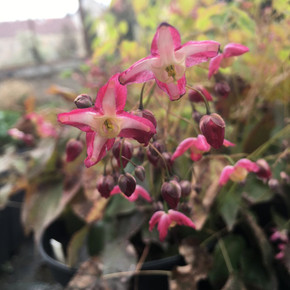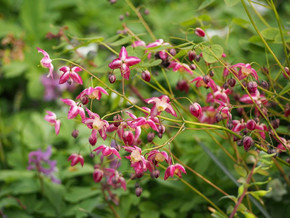
Hypericum prolificum - SHRUBBY ST. JOHNS WORT
This shrub flowers for two months and is "always buzzing,“ as it is very attractive for bumblebees and other pollinators. Nice native plant with showy yellow flowers (¾–1" across). Tolerant to black walnut! It naturally forms rounded mounds, but can be sheared in early spring for a better shape.
Adaptable to soil and moisture. Can be planted in any landscaping project, pollinator garden, butterfly garden, cottage garden, low maintenance planting, rain garden or along roadsides. Looks good with lower-growing and mound-forming perennials or groundcovers, or with smaller shrubs. Try it in combination with the contrasting blue flowers of Geranium x ‘ Rozanne,' Nepeta x faasenii ‘Six Hills Giant‘ (or other variety), or blue varieties of Salvia nemorosa and Veronica! Other good matches are Aster dumosus, other hardy Geranium, Heuchera, Sedum telephium, Waldsteinia, and many other perennials.
Blooming Time: June to August
Size: usually 4’ tall x 3-4’ wide
USDA Zones: 3 to 8
Culture: full sun, half shade, very adaptable to any soil and moisture from dry rocky, sandy soils up to clayish soil. Some drainage is useful. Tolerates drought and brief flooding. Good for erosion control management.
Moisture Needs: dry, medium-dry, medium
Origin: native plant to Central and eastern North America, from Ontario and Maine to Florida and west to Minnesota and east Texas. Threatened in New York and endangered in New Jersey. Indigenous to upland prairies, rocky bluffs, open upland woods, rocky stream banks, swamp margins, old fields, meadows, pastures, etc.
Deer/Rabbit Resistant: yes / yes, unpalatable to herbivores (contains hypericin)
Attracts Butterflies or Pollinators: offers pollen for bumblebees; other less common insect visitors can be Syrphid flies, Halictid bees, butterflies and wasps. Host plant for caterpillars of Gray Hairstreak Butterflies, several beetles and moths.
Attracts Hummingbirds: no
Pot Size: 3.5" x 4" perennial pot (1.22 pt/580 ml)

Hypericum prolificum - SHRUBBY ST. JOHNS WORT
This shrub flowers for two months and is "always buzzing,“ as it is very attractive for bumblebees and other pollinators. Nice native plant with showy yellow flowers (¾–1" across). Tolerant to black walnut! It naturally forms rounded mounds, but can be sheared in early spring for a better shape.
Adaptable to soil and moisture. Can be planted in any landscaping project, pollinator garden, butterfly garden, cottage garden, low maintenance planting, rain garden or along roadsides. Looks good with lower-growing and mound-forming perennials or groundcovers, or with smaller shrubs. Try it in combination with the contrasting blue flowers of Geranium x ‘ Rozanne,' Nepeta x faasenii ‘Six Hills Giant‘ (or other variety), or blue varieties of Salvia nemorosa and Veronica! Other good matches are Aster dumosus, other hardy Geranium, Heuchera, Sedum telephium, Waldsteinia, and many other perennials.
Blooming Time: June to August
Size: usually 4’ tall x 3-4’ wide
USDA Zones: 3 to 8
Culture: full sun, half shade, very adaptable to any soil and moisture from dry rocky, sandy soils up to clayish soil. Some drainage is useful. Tolerates drought and brief flooding. Good for erosion control management.
Moisture Needs: dry, medium-dry, medium
Origin: native plant to Central and eastern North America, from Ontario and Maine to Florida and west to Minnesota and east Texas. Threatened in New York and endangered in New Jersey. Indigenous to upland prairies, rocky bluffs, open upland woods, rocky stream banks, swamp margins, old fields, meadows, pastures, etc.
Deer/Rabbit Resistant: yes / yes, unpalatable to herbivores (contains hypericin)
Attracts Butterflies or Pollinators: offers pollen for bumblebees; other less common insect visitors can be Syrphid flies, Halictid bees, butterflies and wasps. Host plant for caterpillars of Gray Hairstreak Butterflies, several beetles and moths.
Attracts Hummingbirds: no
Pot Size: 3.5" x 4" perennial pot (1.22 pt/580 ml)
Customer Reviews
-
Indiana Native
All of my native plants are healthy and had well developed root systems when I planted them. I'm sure they will grow well and attract pollinators.
-
hardy!
This little shrub is not only adorable but scrappy. It will add a bit of height, color and texture to my little flower bed built into a stone wall and hopefully continue to withstand the chipmunks, rabbits and deer!








